 |
Home | Charity | Feedback |
China: Beijing, Chengdu, Guilin,
Shanghai, Xian
Beijing, China: Size XL by Prakash Bang, Editor in Chief 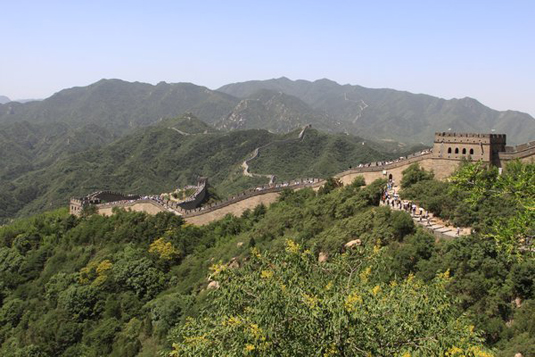 Everything is so big out here. The airport terminal is the largest in Asia (however, it appeared to me as the world's largest); big buildings; big wide roads, big population (17 million and growing); big hotels, big tombs, big squares, big palaces and more recently big stadiums. My English speaking guide Nancy Luo received me at the Beijing Capital International airport. It's a good idea to hire the services of a guide and a private car to move within cities in China. Albeit, road signs are also in English (main roads & sites), I think private services would pay for itself. I was in safe hands of Tang Dynasty Travels. They would look after me in Beijing, Xian, Chengdu, Guilin and Shanghai - my destinations in mainland China. 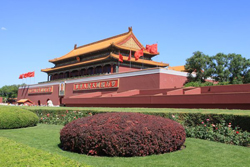 People, cars, buses, trolleys, bicycles, scooters, rickshaws (manual & battery operated) are all in plenty on the Beijing streets. I was amazed to know that despite what I saw around, Beijing ranks only third largest city in China - after Shanghai & Nanjing. 68% of Beijing Province is mountains. Thus the huge population is seen in 32% of the area giving a feel of magnum opus. One child per family is a rule strictly adhered to in all cities. Rural China might get away with more children but generally speaking population growth is well under control.
People, cars, buses, trolleys, bicycles, scooters, rickshaws (manual & battery operated) are all in plenty on the Beijing streets. I was amazed to know that despite what I saw around, Beijing ranks only third largest city in China - after Shanghai & Nanjing. 68% of Beijing Province is mountains. Thus the huge population is seen in 32% of the area giving a feel of magnum opus. One child per family is a rule strictly adhered to in all cities. Rural China might get away with more children but generally speaking population growth is well under control.
Even cars on road enjoy restrictions. Barring taxis and public buses, a car with registration number ending with either 1 or 6 cannot ply on Beijing roads on Mondays. Likewise 2 or 6 are banned on Tuesdays and so on. That's right; Saturdays and Sundays there are no such restrictions. So what happens if you do need to get your car out on your restriction days? Be prepared to pay a fine every time you cross a scanner near the traffic light. It does add up quickly. 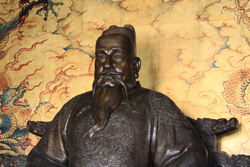 I was hosted at the Capital Hotel's 19th floor. The window overlooked the Forbidden City that looked quite dramatic when illuminated at dusk. Capital is a good business hotel and certainly merits my recommendation. After a good night's rest, my first day schedule included a visit to the Great Wall, Ming Tombs and exploring part of the city on foot.
I was hosted at the Capital Hotel's 19th floor. The window overlooked the Forbidden City that looked quite dramatic when illuminated at dusk. Capital is a good business hotel and certainly merits my recommendation. After a good night's rest, my first day schedule included a visit to the Great Wall, Ming Tombs and exploring part of the city on foot.
The mountains that holds the Great Wall is about 60 kms from Beijing city area. There are mainly two passes from where one can ascend to the wall. I chose the Badaling section, which is more popular and has a cable car that takes you up the mountain. Since this section is widely publicised, it's more popular with domestic tourists. The other section is known as Jiayuguan and is more popular with foreign visitors and is less crowded. However, do bear in mind; it would be a steep walk up to the wall as there's no cable car to offer help. 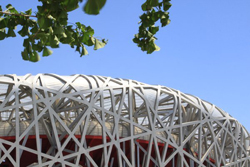 The Great Wall of China was built, rebuilt and maintained by various dynasties - the current and the most famous one being built by the Ming dynasty. The wall was built, in phases, to protect attacks from Mongols, from 5th century BC to 16th century AD. This 6500 kms wonder, also nicknamed the longest tomb, has buried around 3 million men whilst making of the wall. Probably you know that The Great Wall of China is the only man made structure that's visible from space with the naked eye. It's certainly a good idea to walk a portion of the wall.
The Great Wall of China was built, rebuilt and maintained by various dynasties - the current and the most famous one being built by the Ming dynasty. The wall was built, in phases, to protect attacks from Mongols, from 5th century BC to 16th century AD. This 6500 kms wonder, also nicknamed the longest tomb, has buried around 3 million men whilst making of the wall. Probably you know that The Great Wall of China is the only man made structure that's visible from space with the naked eye. It's certainly a good idea to walk a portion of the wall.
On the way back to the city, a detour about midway, will take you the Ming Dynasty Tombs. Of the 16 generations of the Ming Dynasty, 13 tombs are located in the sprawling 40 sq. km. area amidst pristine mountains (Mount Taishou), dark earth and tranquil water reservoir. The location was chosen by the learned based upon the Feng Shui principles. Only 3 tombs are open for public viewing. You see the Changling tomb and you have seen it all. The most dynamic of the Ming's Dynasty was emperor Yongle who reined from 1402 to 1424. His tomb, believed to be the most extravagant is yet to be excavated. The archeologists are expected to commence work only when they are sure about the methods to preserve the treasures. In earlier excavations, thousands of items in wood, silk, porcelain and textiles were found but the same were damaged in course of time. 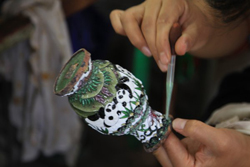 Talking of treasures, on our way to the Great Wall we made a stop at Cloisonné Ware workshop to see the art of inlaying wires in a copper body. And on our return journey we made a stop at a Jade gallery. Of course, when you have a tour guide with you, do expect to make stops at such locations. But honestly, there are no regrets. Both the places were worth the time as we got to see craftsmen on the job.
Talking of treasures, on our way to the Great Wall we made a stop at Cloisonné Ware workshop to see the art of inlaying wires in a copper body. And on our return journey we made a stop at a Jade gallery. Of course, when you have a tour guide with you, do expect to make stops at such locations. But honestly, there are no regrets. Both the places were worth the time as we got to see craftsmen on the job.
Next morning, it was a good 15 minute walk from my hotel to Tiananmen Square now officially known as Great Hall of the People. This is the largest public square in the world that can hold over 1 million people. This is also the same sight of the protest of 1989 that had left scores of people dead. The Tiananmen Gate was first built in 1420 in the Ming Dynasty. The Tiananmen Square was built in 1651 and was enlarged and cemented to four times its original size in 1958. Standing amidst the massive square is the Monument of the People's Heroes and also Mao's mausoleum. The Tiananmen Gate leads to the Forbidden City. 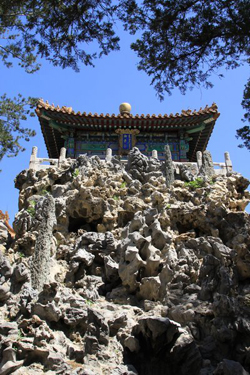 The Forbidden City was the Chinese Imperial Palace from the Ming Dynasty to the end of the Qing Dynasty. For almost five centuries, it served as the home of the Emperor and his household, as well as the ceremonial and political centre of Chinese government. Built from 1406 to 1420, the complex consists of 980 surviving buildings with 8707 bays of rooms and covers 720,000 square metres. The site is the world's largest surviving palace complex and is a fine example of traditional Chinese architecture.
The Forbidden City was the Chinese Imperial Palace from the Ming Dynasty to the end of the Qing Dynasty. For almost five centuries, it served as the home of the Emperor and his household, as well as the ceremonial and political centre of Chinese government. Built from 1406 to 1420, the complex consists of 980 surviving buildings with 8707 bays of rooms and covers 720,000 square metres. The site is the world's largest surviving palace complex and is a fine example of traditional Chinese architecture.
The site of the Forbidden City was situated on the Imperial city during the Mongol Yuan Dynasty. Upon the establishment of the Ming Dynasty, the Hongwu Emperor moved the capital from Beijing in the north to Nanjing in the south, and ordered that the Yuan palaces be razed. When his son Zhu Di became the Yongle Emperor, he moved the capital back to Beijing, and construction began in 1406 of what would become the Forbidden City. The palace is divided in to outer and an inner court. If you were to visit the site in summers, be sure to carry an umbrella. There's no shade save for the various rooms that you cross on the way. Like all tourist spots, even the Forbidden City was witness to hordes and hordes of domestic visitors. The entrance fee was RMB 60 per person. At the time of writing US$1 got me about RMB 6.7. RMB stands for Ren Min Pi which means people's money. RMB is also known as Yuon. After money & couple of hours well spent, I decided to use the subway to take me to the Olympic Greens. 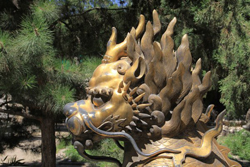 Beijing has large and modern subway system. It has 8 lines, extremely efficient and very cheap too. Just RMB2 takes you from anywhere to anywhere… and you can touch all corners of the sprawling city with ease. Yes it does get crowded but then that's China. Maps and directions are pretty easy to follow. Change of 2 lines got me straight into the Olympic Park. Since time and energy were scarce, I decided to explore the Bird's Nest and of course The Cube. Both the structures are engineering & architectural marvel. There's an entrance fee of RMB 50 and RMB 30 each respectively to get within the stadium. I strongly recommend a visit to both. The pictures will tell you more.
Beijing has large and modern subway system. It has 8 lines, extremely efficient and very cheap too. Just RMB2 takes you from anywhere to anywhere… and you can touch all corners of the sprawling city with ease. Yes it does get crowded but then that's China. Maps and directions are pretty easy to follow. Change of 2 lines got me straight into the Olympic Park. Since time and energy were scarce, I decided to explore the Bird's Nest and of course The Cube. Both the structures are engineering & architectural marvel. There's an entrance fee of RMB 50 and RMB 30 each respectively to get within the stadium. I strongly recommend a visit to both. The pictures will tell you more.
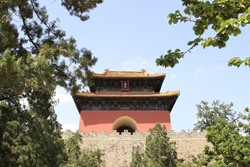 The subway got me back to the hotel and after a quick shower I thought to use the rickshaw to show me around the neighbourhood. The National Centre of Performing Arts was a massive structure standing amidst a water reservoir. Sadly, I had left the camera in my room. It would have been an awesome picture. These rickshaws are powered by battery. However, the drivers prefer to pedal off and on. Despite the fact that the fare had been very clearly negotiated, be prepared to get hassled during drop off. The drivers will take out some kind of an English guide to show you the payable fares. I had negotiated for the trip for RMB 30. I was shown a chart to pay RMB 300! Of course, I put up a brave front and stood my grounds. You may not be lucky especially if the drop off point is not a busy street. Be warned!
The subway got me back to the hotel and after a quick shower I thought to use the rickshaw to show me around the neighbourhood. The National Centre of Performing Arts was a massive structure standing amidst a water reservoir. Sadly, I had left the camera in my room. It would have been an awesome picture. These rickshaws are powered by battery. However, the drivers prefer to pedal off and on. Despite the fact that the fare had been very clearly negotiated, be prepared to get hassled during drop off. The drivers will take out some kind of an English guide to show you the payable fares. I had negotiated for the trip for RMB 30. I was shown a chart to pay RMB 300! Of course, I put up a brave front and stood my grounds. You may not be lucky especially if the drop off point is not a busy street. Be warned!
Anyway, the episode was behind me. I needed much needed rest for an early check-out the next morning. It will be another long day in Xian - my next destination. Be careful to note your departure gate. The airport complex is huge. Miss a terminal and you may lose valuable time to find your way to the correct terminal. Whilst at it, make it a point to note the 'Dragon & Turtle' shape of the airport. The two auspicious Chinese symbols depicting strength and longevity respectively. Beijing Image Gallery  Photo viewer Photo viewer
|
|
|
Home |
Charity |
Feedback
Privacy Policy | Terms of Usage © YoGoYo.com. All rights reserved. |









































